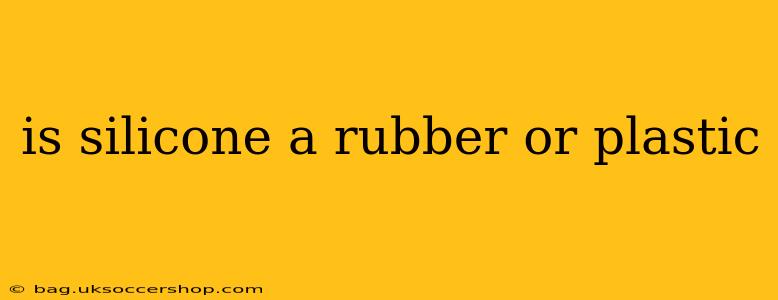Is Silicone a Rubber or Plastic? Understanding the Material's Unique Properties
Silicone is often mistakenly categorized as either rubber or plastic, but it's actually a unique material with properties that bridge the gap between the two. Understanding this distinction requires delving into its chemical composition and how that impacts its behavior.
This article will explore the characteristics of silicone, comparing and contrasting it with rubber and plastic to answer definitively whether it's one or the other, and importantly, why the question itself is misleading. We'll also address some frequently asked questions surrounding silicone's nature.
What is Silicone?
Silicone, or polysiloxane, is a polymer made up of a silicon-oxygen backbone chain, with organic side groups attached to the silicon atoms. This unique structure is responsible for its distinct properties, differing significantly from both natural and synthetic rubbers and most plastics.
How Does Silicone Differ from Rubber?
Natural rubber comes from the latex of rubber trees, and synthetic rubbers are created through chemical processes often mimicking the structure of natural rubber. Both are primarily composed of carbon and hydrogen, forming long chains of repeating units.
Silicone, on the other hand, incorporates silicon and oxygen into its backbone, giving it significantly different properties:
- Heat Resistance: Silicone boasts far superior heat resistance than most rubbers. It can withstand much higher temperatures before degrading.
- Flexibility at Low Temperatures: While many rubbers become brittle at low temperatures, silicone maintains its flexibility.
- Water Repellency: Silicone exhibits excellent water repellency, while rubbers can absorb water to varying degrees.
- Chemical Inertness: Silicone is more resistant to chemicals and solvents than many rubbers.
While both silicone and rubber can be elastic and flexible, their underlying chemical structures and resulting properties distinguish them.
How Does Silicone Differ from Plastic?
Plastics are a broad category of synthetic materials, with many different types and properties. However, most plastics, like polyethylene or polypropylene, are based on carbon chains.
Silicone again distinguishes itself through its silicon-oxygen backbone:
- Heat Resistance: Many plastics degrade at much lower temperatures than silicone.
- Flexibility: While some plastics are flexible, silicone generally maintains superior flexibility over a broader temperature range.
- Chemical Resistance: Silicone often surpasses common plastics in chemical resistance.
- UV Resistance: Silicone typically has better UV resistance, making it more suitable for outdoor applications.
The key difference lies in their chemical composition and resulting properties. While both can be molded into various shapes, their molecular structures dictate very different performance characteristics.
Is Silicone a Rubber or a Plastic? The Answer
The question itself is a simplification. Silicone shares certain characteristics with both rubbers and plastics, such as elasticity and moldability. However, its unique chemical structure and resulting properties set it apart from both categories. Therefore, it's more accurate to classify silicone as a distinct class of material rather than trying to force it into the rubber or plastic categories.
What are the common uses of silicone?
Silicone's unique properties make it suitable for a broad range of applications, including:
- Sealants and adhesives: Its ability to withstand extreme temperatures and remain flexible makes it ideal for sealing and bonding applications.
- Medical devices: Biocompatibility and inertness make it a safe material for medical implants and devices.
- Cookware: Heat resistance and non-stick properties make it suitable for baking and cooking utensils.
- Electronics: Its electrical insulation properties make it useful in electronics and electrical components.
- Cosmetics and personal care products: Its softness and smoothness make it a popular ingredient in many personal care items.
What are the advantages of using silicone?
The advantages of using silicone are numerous and depend on the specific application, but generally include:
- Excellent heat resistance
- High flexibility over a wide temperature range
- Water repellency
- Good chemical resistance
- Biocompatibility (in certain grades)
- Non-stick properties
In conclusion, while silicone shares some superficial similarities with both rubbers and plastics, its distinct chemical composition and properties clearly differentiate it as a unique and valuable material. Rather than trying to fit it into existing categories, it's best understood and appreciated for its individual characteristics and broad applications.
